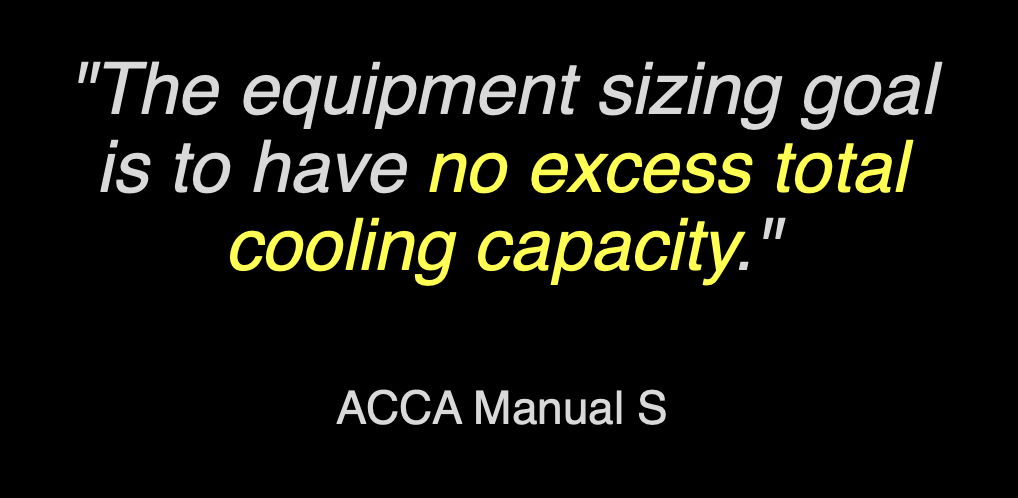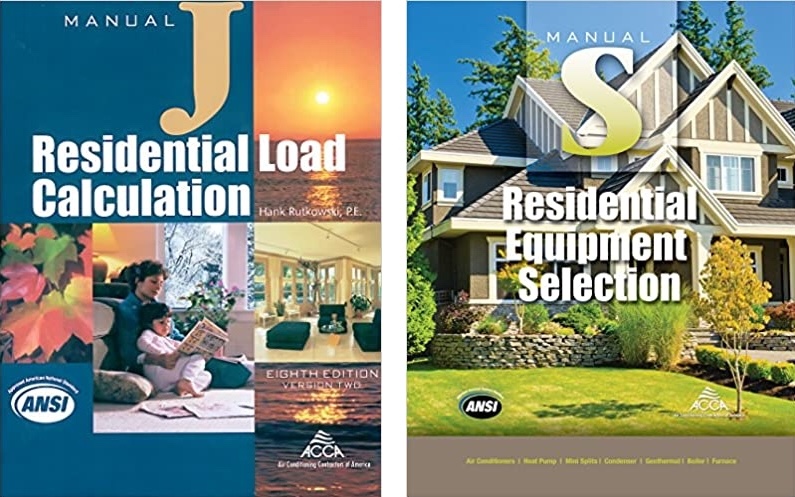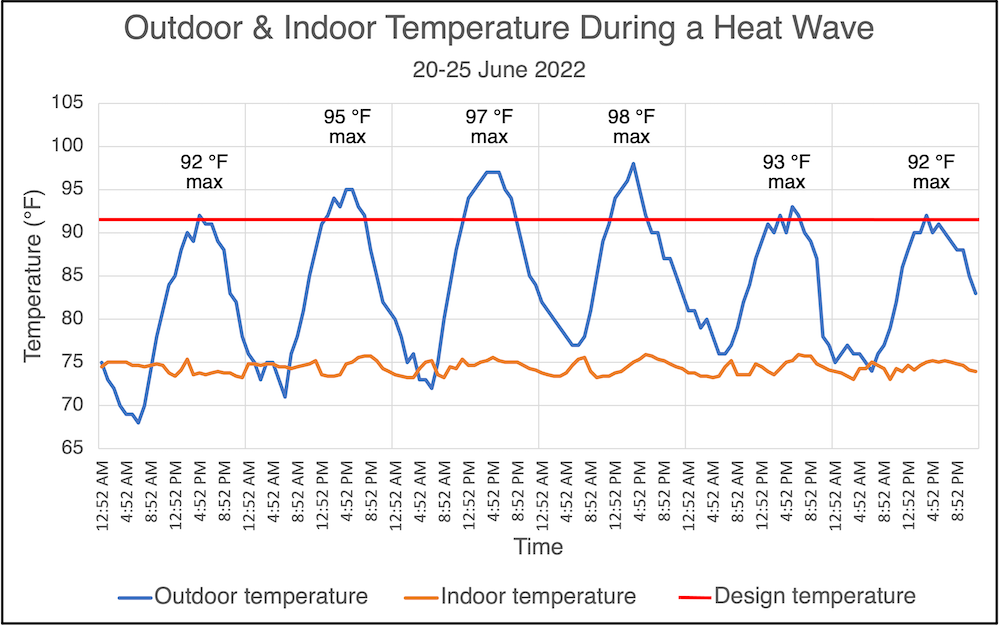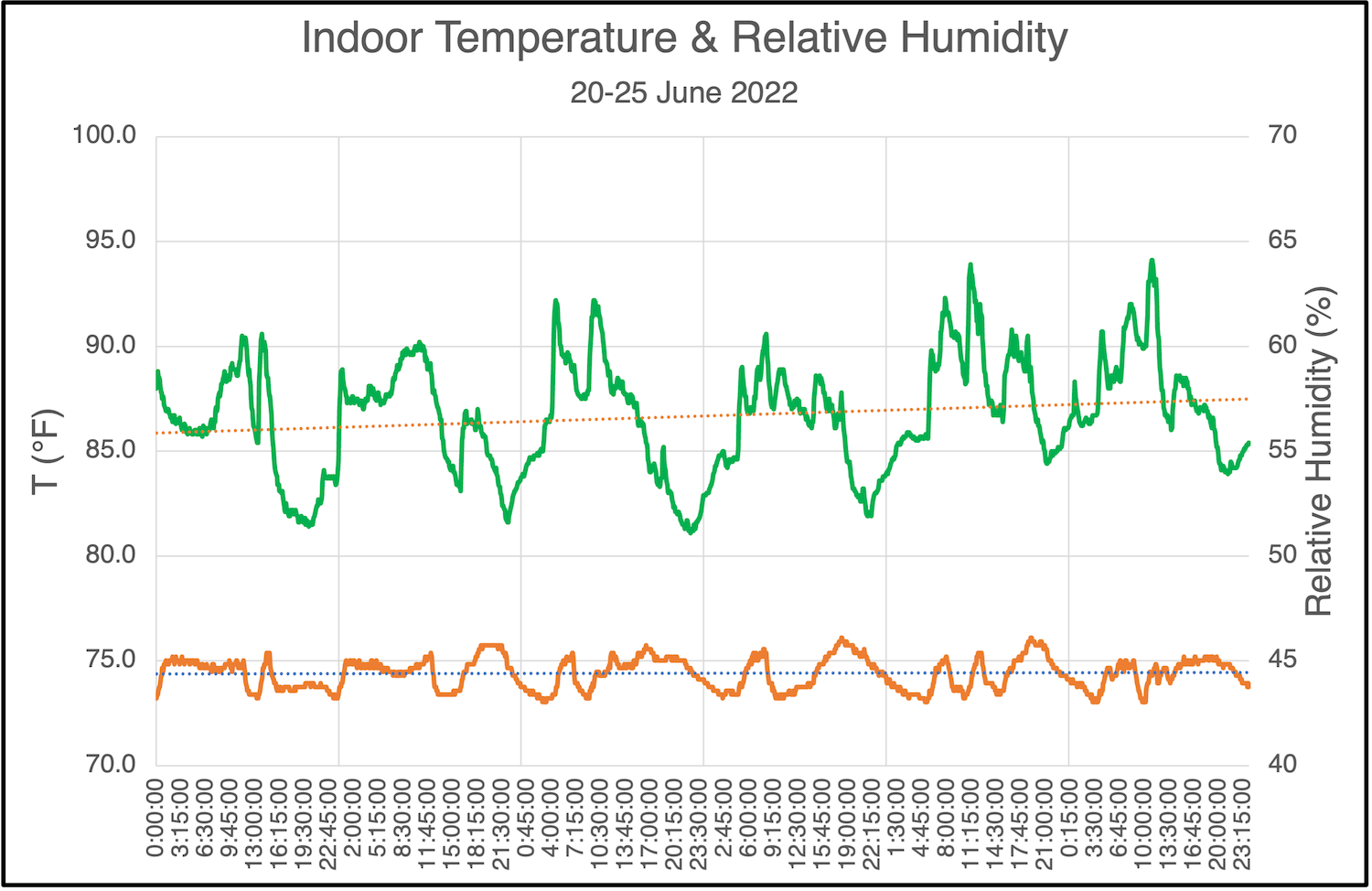
At the 5th annual HVAC School Symposium in Florida, I gave a talk on undersized heating and cooling systems. You know, those systems that just can’t keep the house warm enough in winter or cool enough in summer. In this article, though, I’m going to pull out just one part of that talk: what it means to have a properly sized air conditioner. And it also applies to heat pumps in cooling mode, but I’ll mostly include both under the name of air conditioners.
Ready? Here we go.
The goal
When you’re following proper protocols for sizing an air conditioner, the idea is to have just the right amount of cooling capacity when the house is at the standard design conditions. I’ll get into the design conditions below, but first, the industry trade group Air Conditioning Contractors of America (ACCA) says very clearly what it means to have properly sized air conditioner.

This quote is from the Manual S equipment selection protocol. You can find this statement in the overview section at the beginning of the book.
Now, there’s a whole lot going on in that sentence above, so let’s deconstruct it.
The sizing process
First, it’s critical to understand the two big quantities we’re dealing with here: cooling load and cooling capacity. The load tells you how much cooling a house needs. The capacity tells you how much cooling the equipment can do.
Second, with cooling, we can divide both load and capacity into two different types: sensible and latent. Sensible cooling is related to changing the temperature. Latent cooling is all about the heat carried by water vapor. It takes energy to remove both forms of heat, and that’s what an air conditioner does.

Third, ACCA has HVAC design protocols for all this. You start with a Manual J cooling load calculation. It gives you both the sensible and latent cooling loads for the house. Then you do the Manual S equipment selection to make sure the air conditioner can handle both the sensible and latent cooling loads. (If you’re looking for someone to do this for you, we can help.)
Design conditions
As I mentioned above, the HVAC designer will do the load calculation and sizing protocol for specific design conditions. The Manual J indoor conditions are the same everywhere: 70 °F in winter and 75 °F with 50 percent relative humidity in summer. The outdoor conditions depend on the location, and mostly it’s the 99 percent and 1 percent design conditions.
Basically, what the 99 percent and 1 percent refer to are the temperatures that a location is above 99 percent of the time for heating and 1 percent of the time for cooling. In other words, the temperature goes below the winter design temperature or above the summer design temperature only 88 hours per year. (There are 8,760 hours per year, so 1 percent of that is 87.6, or 88 hours rounded.)
Real conditions
But here’s the thing. What about all the other hours of the year? Our summer design temperature in Atlanta is 92 °F. So, we’re above that temperature 88 hours per year. We’re at or below it 8,672 hours per year. Obviously, we don’t need cooling for all those other hours because a lot of them happen when the outdoor temperature is low enough .
Now, thinking about how the conditions change all the time, we can divide the loads into three types:
- Design load
- Extreme load
- Part load
We design for the first one, but the house doesn’t spend all that much time right at the design conditions. Occasionally we have more cooling load (extreme load). And then there’s the vast majority of the time when we need some cooling but not as much as we’ve designed for (part load).
So, what’s a person to do?
A look at design and extreme day performance
Here’s an example of a system I designed. It’s the heat pump serving most of the main floor in my house (details here). Since we’re focusing on air conditioning here, I’m going to ignore the heating side. You may recall that I wrote about how well my system did when we had a little heat wave in Atlanta a couple of years ago. Here’s the graph of indoor and outdoor temperatures over a six day period as the heat wave rolled through.

The first of those six days was a design day. Well, OK, it was really more like a design few hours. We hit our design temperature of 92 °F for an hour or so and were close for a couple more hours. And notice that the indoor temperature held at 74 °F through and after the peak.
I sized the system for the standard indoor design temperature of 75 °F but usually keep the thermostat set at 74 °F in summer. So if I designed for 75 °F and held 74 °F, that means my system is oversized, right? Based on that quote from Manual S above, I’d say yes, at least for the sensible cooling.
An undersized cooling system
The table below shows the ACCA Manual S sizing limits for air conditioners and heat pumps in cooling mode. The numbers are the multipliers you use with the Manual J cooling load to find the range of acceptable installed total cooling capacity of the equipment. The three rows are for the different types of equipment. In my case, the system is a variable-capacity heat pump.

I showed the loads, equipment model numbers, and capacities in my first article on this heat pump back in 2020. The cooling capacity is 88% (0.88) of the cooling load. Yes, I undersized it, relative to both the cooling load and the Manual S minimum. But the temperatures above show that it worked fine and even had a bit of excess sensible cooling capacity on that first design day. So I’d say I have a properly sized air conditioner.
What does this say about Manual J and manufacturer equipment data? Well, one or the other or both have some uncertainty. But let’s assume the equipment capacity is correct and that it matched the actual load on the design day. That means the Manual J cooling load (21,341 BTU/hr) is 13% higher than the actual load (18,862 BTU/hr).
What about humidity?
Now, the total cooling load and capacity numbers comprise two parts: the sensible and latent components. I showed above that the undersized system in my house handles the sensible load just fine. That’s because it kept 75 °F or better on that first design day. But what about the latent cooling? The indoor design condition for relative humidity is 50%.
Here’s the graph of my humidity data for that six day heat wave.

No, it definitely didn’t hold at 50%, even on the initial design day. But remember that we want to keep relative humidity in a range of about 30 to 60% according to the Sterling chart. Also, modern high efficiency equipment has less latent cooling capacity. And here’s where, at least according to the manufacturer’s data for my Mitsubishi system, the system is greatly undersized.
The latent cooling load is 3803 BTU/hr, and the latent cooling capacity is a mere 718 BTU/hr. I think the graph of humidity data above shows that Mitsubishi’s number is wrong. If I really had only 19% of the latent capacity I needed, the relative humidity percentage would have been much higher than the mid-to-upper 50s. I didn’t have any supplemental dehumidification going on so this system kept the humidity in check; this system was removing moisture.
A few takeaways
The data I’ve shown here is for one heat pump from one manufacturer, so your mileage may vary with other equipment. That said, here are a few takeaways:
- A properly sized air conditioner is based on not having excess total cooling capacity.
- Manual J cooling loads and manufacturers’ equipment capacity data have some uncertainty. (As do all real-world numbers.)
- You probably don’t need to worry so much about ending up with undersized equipment that can’t handle the load.
I tried to be as accurate as possible in the load calculation for my house, adding no extra load as a “safety factor.” I undersized the system. And everything worked perfectly for cooling.
In my house, the cooling loads turned out to be about 1300 sq. ft. of conditioned floor area per ton of load. (See how this compares to others.) The equipment capacity was even better. And this is a 1961 house.
As I said in my talk at the HVAC School Symposium last week, I’m willing to risk my marriage for the good of the HVAC industry and homeowners. The good news is that my marriage is intact.
____________________________________________________________________
Allison A. Bailes III, PhD is a speaker, writer, building science consultant, and the founder of Energy Vanguard in Decatur, Georgia. He has a doctorate in physics and is the author of a bestselling book on building science. He also writes the Energy Vanguard Blog. For more updates, you can subscribe to Energy Vanguard’s weekly newsletter and follow him on LinkedIn. Images courtesy of author.
Weekly Newsletter
Get building science and energy efficiency advice, plus special offers, in your inbox.















One Comment
" Since we’re focusing on air conditioning here, I’m going to ignore the heating side."
But isn't that the interesting side? Or rather, the interplay between the two? Because equipment also has to be sized properly for cooling. Yet there's no interplay between the two, the heating load can be larger, smaller or the same, it all depends on the climate. How do you reconcile that?
Log in or create an account to post a comment.
Sign up Log in